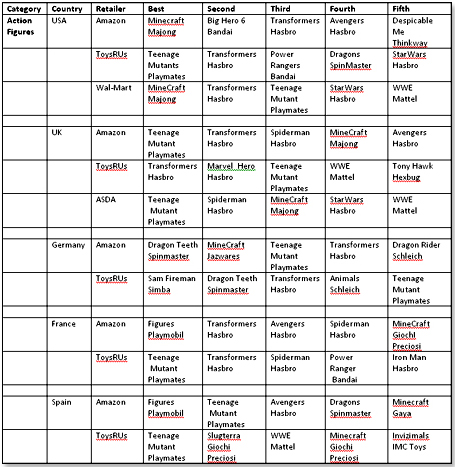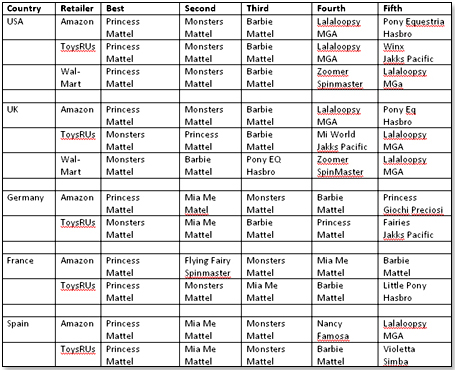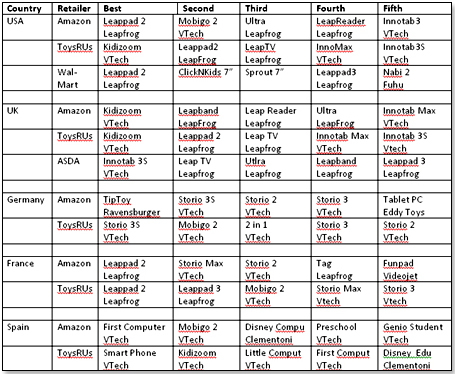 |

Tools:








The Western Toy Market
2014 has been a tumultuous year. We witnessed the unparalleled success of Frozen; we saw the entry of two new hybrids, Lego Fusion and Nintendo's amiibo and the rapid inroads the hybrids are making into Action Figures and Preschool ; Disney decided to move its Princess fashion doll range from Mattel to Hasbro in 2016; and we watched the on-again-off-again efforts by DreamWorks to flee into the arms of a would-be suitor such as Hasbro.
We said "good-bye" to a whole bunch of smallish toy manufacturers acquired by their bigger brothers. We also observed the continued and accelerating rise of online toy sales. Most importantly, we saw the recession-induced consumer strategy of moving down the price scale and to substitute, particularly in the preschool category. This could now well turn around. With lower gasoline prices, a better employment picture, rising minimum wages, and an uptick in consumer confidence, the outlook for toys over the medium to long term is better than it has been for years.
It had also been a reasonably good year for toys. As I predicted already back in October 2014, U.S. toy sales increased at a rate of 4% whereas Europe did slightly better than that if one does not include the Russian meltdown and the Euro and Pound Sterling currency corrections.
This review will look at the two largest toy markets – the United States and Europe; for the latter, the focus will be on the four keystone countries France, Germany, Spain and the UK.
First, Market Size:
The worldwide traditional toy market is estimated to amount to $84 Billion at retail – not including video games or hybrids. Of this, the five countries under review take the following shares:
Source: Klosters Retailer Panel
In other words, we see moderate growth for all five.
Secondly, distribution patterns:
The U.S. toy market is totally dominated by four players – Amazon, Target, ToysRUs and Wal-Mart. This is how the market shares developed up to end of October based on the metrics of the Klosters Retailer Panel:
Source: Klosters Retailer Panel
In Europe, the picture is less clear-cut. This is how the individual four countries break out based on feedback from national buyers at the major retailers in these countries.
France:
Toy retail is divided between three brick-and-mortar retailer groups, all of which have about the same share of the pie, and Amazon as the clear online leader. Mass retailers such Carrefour, Groupe Auchan, Groupe Casino, Systeme U and others have about 30% of the market; Specialty toy retailers such as ToysRUs and La Grand Recre take about 25% ; independent local specialty stores have about 30%] and Amazon holds 15% of the market.
Germany:
The Germany toy space is dominated by a vast number of small mom-and-pop specialty stores which are estimated to account for 45% of the German toy market. Large supermarkets and department stores such as Kaufhaus, Karstadt, Muller and Rossmann take another 20%. ToysRUs has about 10%, and the two leading online retailers – Amazon and myToy – take the remainder with about 25%.
Spain:
Hypermarkets such as El Corte Ingles, Carrefour, Al Campo and Groupe Auchan, are taking an increasing share of the toy market and now hold an estimated third of the market. ToysRUs has a market share of about 12%. Online retailers such as Amazon and Juguetos control about 18% and the rest is solidly in the hands of specialty retailers.
United Kingdom:
The mass retailers ASDA, Tesco, and Sainsbury are continuing to gain market share and now hold approximately 20%. However, the real action is with the Specialty Retailers – Argos, ToysRUs, Smyths and Hamleys - who, between them, have a market share of about 40%. Online sales, led by Amazon, have over the years increased rapidly and now are about on the same level as the U.S. – thirty percent. Finally, small specialty retailers are doing badly and have sunk to a share of 10% which is again about the same as in the U.S.
Thirdly, the advance of the online toy business:
Online is growing rapidly in all five countries and this in all instances is driven by Amazon. However, it has to be understood that Amazon's toy business consists of two parts. One is the part where Amazon is the primary vendor – the company buys directly from the Mattels and Hasbros of this world and resells to the consumer. The second part is where third-party vendors, mainly small manufacturers, offer their goods via Amazon but ship directly. Of the two, the latter is larger and growing more rapidly.
This is how the share of online toy sales break out for each country:
Fourth, seasonality:
The five weeks leading up to Christmas have always been extremely important and remain so. However, because of the much earlier onset of promotional offers for toys – Black Friday promotions starting a month before the real date, increased Layaway promotions etc. – the weight of sales shifted to early November on one side and to the second half of December on the other. As a result, the two weeks between November 18 and December 12 were disappointing.
Fifth, Toy Bestsellers:
We asked the national buyers at leading retailers – Amazon, ToysRUs and Wal-Mart - what their best selling toy brands were for the week ending December 22. We selected three toy categories – Action Figures, Fashion Dolls, and Electronic Learning Consoles – on the premise that these best show the differences or the similarities between the five countries reviewed.
Action Figures:

Source: National Buyers Segment (U.S. and Europe) of Klosters Retailer Panel
In the case of Action Figures, three-quarters were licensed products and of these, more than two-thirds were based on 2015 or 2013 movies. France was the country with the highest percentage of licensed products whereas Germany had the least. The three top properties were Teenage Mutant Ninja Turtles (9), Transformers (8) and MineCraft (7). MineCraft was recently acquired by Microsoft and it will be interesting to see what the company will do as this relates to their newly acquired stake in the toy biz.
However, this line-up does not include hybrids, particularly the Skylanders and Infinity, since these are generally not considered toys even though the figurines represent about 85% of the sales of both ranges. It is generally thought that the Skylanders are making major inroads of the Action Figure category whilst Infinity is going against Action Figures and Preschool equally.
Fashion Dolls:

Source: National Buyers Segment (U.S. and Europe) of Klosters Retailer Panel
Mattel sweeps the board with nearly three-quarters of the fifty positions surveyed. Surprising in this is the strong European presence of Mi Me of Mattel, a winged fairy accompanied by a unicorn. While Monsters lead the pack in terms of positions (12) over Frozen (11) and Barbie (11), the overall sell-through is very clear: Frozen is the leader by a solid margin, followed by Monsters as #2 and a reasonably distant Barbie as #3. Licenses represent only 30% of these top fifty positions which is mainly a function of Mattel's strategy to focus on own IPs rather than on licensed products.
Electronic Learning Consoles:

Source: National Buyers Segment (U.S. and Europe) of Klosters Retailer Panel
Where the language is English – the U.S. and U.K. – Leapfrog wins hands down. LeapFrog is also now available in French – hence the company's relatively strong position in France. In Germany and Spain, two countries in whose languages Leapfrog is not available, VTech is the clear leader and Leapfrog is nowhere to be seen. Furthermore, other tablets are beginning to make inroads – definitely in the United States but also in France, Germany and Spain.
In summary, while there are strong local companies in the various countries, Mattel and Hasbro still dominate the market place across the board and there is no real difference between the U.S. and Europe in this respect. The same is the case in the Electronic Learning Consoles where either Leapfrog or Vtech take home the bacon.
Licenses continue to be the way to go and the best ones tend to go to the strongest companies. The old truism still applies here – if you are not very strong in a given market, you do not get the best licenses; and without the best licenses, you do not get to be very strong.
However, the major difference is in the distribution channels. Mass retailers dominate in the U.S. and the U.K. whereas department stores and small specialty retailers have the lion's share elsewhere. In all countries, online commerce in toys is growing rapidly but has reached its highest level in the U.S. and the U.K. with the other three countries still lagging behind. Now, after Ali Baba's IPO, everybody is waiting to see how the Chinese online giant will change the North American and European online space.
 Writer's Bio: Writer's Bio: Lutz Muller is a Swiss who has lived on five continents. In the United States, he was the CEO for four manufacturing companies, including two in the toy industry. Since 2002, he has provided competitive intelligence on the toy and video game market to manufacturers and financial institutions coast-to-coast. He gets his information from his retailer panel, from big-box buyers and his many friends in the industry. If anything happens, he is usually the first to know. Read more on his website at www.klosterstrading.com. Read more articles by this author
THIS BANNER IS AN AD:

Back to TDmonthly's front page
|  |
Advertise on TDmonthly

|

